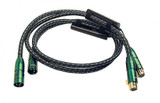Taking the test

AudioQuest Columbia XLR Balanced Interconnects
Some of the things people talk about in high end audio are actually very subtle and hard to even experience unless everything in your system is set up right. Things like P.R.A.T. (Pace, Rhythm, And Timing), musicality, soundstage depth, tonal truth, and more.
Maybe the only hifi buzzword you can experience without a proper setup would be the stereotypical “black background.” Turn off your stereo, and there you go.
Nyuk, nyuk. Wise guy eh?
When folks get all up in arms about hifi snake oil, and they claim, red-faced, that no one can tell the difference between $10K speaker cables and a coat hanger, one has to assume that these people A) have never heard the cables they deride, and B) have not set up a proper test for themselves to compare cables more closely related than say a set of Wireworlds and a strip of tin foil.
Number one step in the process to hear and contemplate the contribution that cables make to the overall presentation is to set up the speakers and listening position perfectly. Seriously — that’s step one. No big deal!
There are many schools of thought on this step, including the interesting Sukimo Master Set speaker placement method.
After that, there is a lot of listening and small adjustment, and then attention paid to things like power cables (listening to changes all the while), setting a baseline standard for interconnects and speaker cables, gear stands and isolation of electronics, USB re-clocking, etc.
When you’re in the sweet spot and the system is a lean, mean music machine, swapping out a pair of interconnects can make an immediate and very satisfying (or saddening!) change to the sound. The change can be subtle or limited in scope but because of the complexity of music, can cause a sea change in the way the sound is perceived.
For instance, this morning before anyone else got into work at The Music Room I fired up a Gary Burton album I had just discovered the day before. It’s called Time Thread by Gary and Makoto Ozone.
This recording has enough depth and nuance and detail to be my cable testing partner as I discover what these AudioQuest Columbia XLR interconnects bring to the table. This record is perfect also because Gary’s vibraphone has so much depth and nuance itself, rivaled in resonant, rich harmonics only by Makoto’s piano.
Add some real reverb and a live-ish feel to the performance and you’ve got sonic cues so complex and delicate as to really illuminate any changes.
And because music is so varying and intricate itself, it’s my belief that each proper comparison requires several minutes of music. You need to really catch some good sections of tone and transient and sometimes you have to wait for it.
But also, I think our brains need a little time to digest and analyze things as complex as what we’re hearing and listening for in a cable comparison.
So how do AudioQuest’s Columbia XLR ICs affect the sound of this masterful record? Well, let’s go through the buzzwords. The most apparent upgrade is in soundstage, and because both instruments were stereo-miked it’s instantly recognizable as more real when you hear different notes literally living in their own spot along a horizontal plane in front of you. Same goes with the piano.
With lesser cables, I get some of this sensation, but the delineation between notes in space like it is is less accurate. It’s more of a mash of most of the notes in the middle, with just the lowest and highest notes throwing the sound to the edges.
P.R.A.T. applies to a few aspects of music, and cables really do affect a system’s “pratiness.” You hear it on the transients — the vibraphone mallet strikes — sensing a little bit of a bass element in each hammer strike. You hear it on the undulating, throbbing piano backing, coming through as a sensation of dynamic force.
Musicality, as provided by cables, shows up when Gary lets a note hang long, like at the very end of Part I “Lyon In the Morning - I Hear Trouble!” (around 3:52). If the note holds its shape in your mind as a vibraphone strike with the sustain pedal down, the cables are doing their job well. If it disintegrates after a few seconds and moves in apparent soundstage position at all, they are not.
I’ll wrap up this long winded diatribe about audio snake oil and the effect of cables by saying once again: If you know anyone who swears that zip cord is the zenith of audio cable science, have them talk to me.
The testers back here at The Music Room have each heard a massive slew of different cables. Each of us will tell you cables can change the sound dramatically. After my cable testing this morning I share nothing with the approach of coat hanger guy. I’ve listened to a ton of different designs, and I’ve done the work to compare them for myself in honest tests.
And these AudioQuest Columbia cables just kick ass, man. They are right up there in the mix with my favorite interconnects I’ve heard.
Comment below if you’ve done some cable testing of your own!
